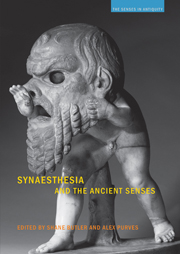Book contents
- Frontmatter
- Contents
- Contributors
- Introduction: synaesthesia and the ancient senses
- 1 Why are there nine Muses?
- 2 Haptic Herodotus
- 3 The understanding ear: synaesthesia, paraesthesia and talking animals
- 4 Aristophanes, Cratinus and the smell of comedy
- 5 “Looking mustard”: Greek popular epistemology and the meaning of δριμύς
- 6 Plato, beauty and “philosophical synaesthesia”
- 7 Manilius' cosmos of the senses
- 8 Reading death and the senses in Lucan and Lucretius
- 9 Colour as synaesthetic experience in antiquity
- 10 Blinded by th light: oratorical clarity and poetic obscurity in Quintilian
- 11 The sense of a poem: Ovids Banquet of Sence (1595)
- 12 Saussure's anaphonie: sounds asunder
- 13 Beyond Narcissus
- Bibliography
- Index
1 - Why are there nine Muses?
- Frontmatter
- Contents
- Contributors
- Introduction: synaesthesia and the ancient senses
- 1 Why are there nine Muses?
- 2 Haptic Herodotus
- 3 The understanding ear: synaesthesia, paraesthesia and talking animals
- 4 Aristophanes, Cratinus and the smell of comedy
- 5 “Looking mustard”: Greek popular epistemology and the meaning of δριμύς
- 6 Plato, beauty and “philosophical synaesthesia”
- 7 Manilius' cosmos of the senses
- 8 Reading death and the senses in Lucan and Lucretius
- 9 Colour as synaesthetic experience in antiquity
- 10 Blinded by th light: oratorical clarity and poetic obscurity in Quintilian
- 11 The sense of a poem: Ovids Banquet of Sence (1595)
- 12 Saussure's anaphonie: sounds asunder
- 13 Beyond Narcissus
- Bibliography
- Index
Summary
If you want to know why there are nine Muses, you just have to ask Homer. Homer knows either one or several nameless Muses of some indefinite number, as at Iliad 1.604 (“the antiphonal sweet sound of the Muses singing”) or Iliad 2.484 (“Tell me now, you Muses, who have your homes on Olympus”), Iliad 2.761 (“Tell me, then, Muse, …”), or Odyssey 1.1 (“Sing to me, Muse”). They remain in this indefinite state until the last book of the Odyssey, where the Muses are said by Agamemnon's psychē in the Underworld to appear finally on Earth – already a peculiar topographical and narrative inversion in itself – in order to lead a thrēnos at the funeral of Achilles. Only, they do so both as a chorus of nine and in the seemingly abstract and faceless singular:
And all the nine Muses in sweet antiphonal singing
mourned you, nor would you then have seen anyone of the Argives
not in tears, so much did the singing Muse stir them.
(Odyssey 24.60–3; trans. Lattimore 1965)Hesiod follows suit in the Theogony, either conferring or transmitting the nine distinct names of nine Muses, otherwise not functionally distinct, in a gesture that was destined to become canonical.
Elsewhere, their number varies wildly. Ephorus knows three Muses, others give four, five, seven or eight. And the iconography is in agreement. Sappho sometimes makes a tenth, but that is as far as it goes.
- Type
- Chapter
- Information
- Synaesthesia and the Ancient Senses , pp. 9 - 26Publisher: Acumen PublishingPrint publication year: 2013



